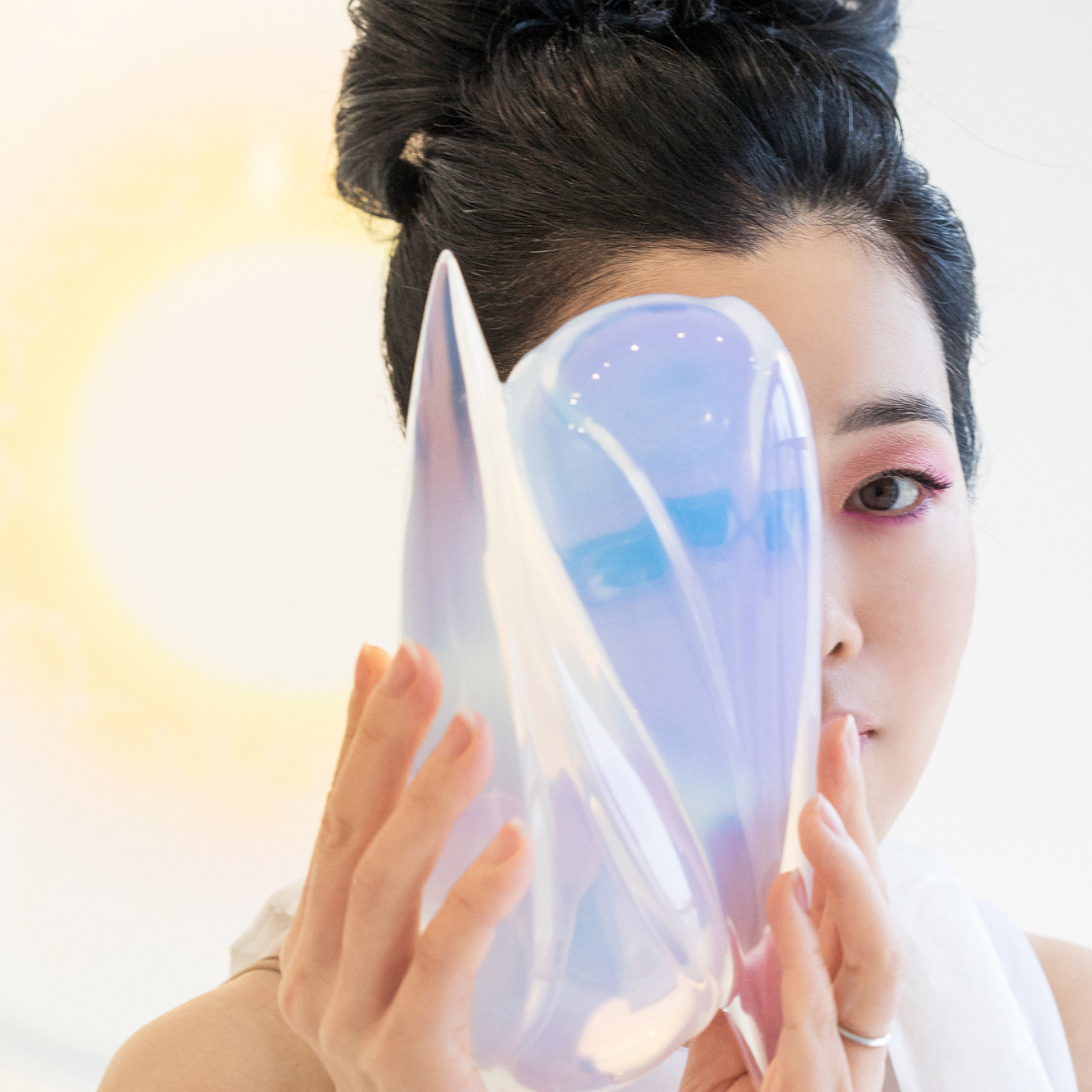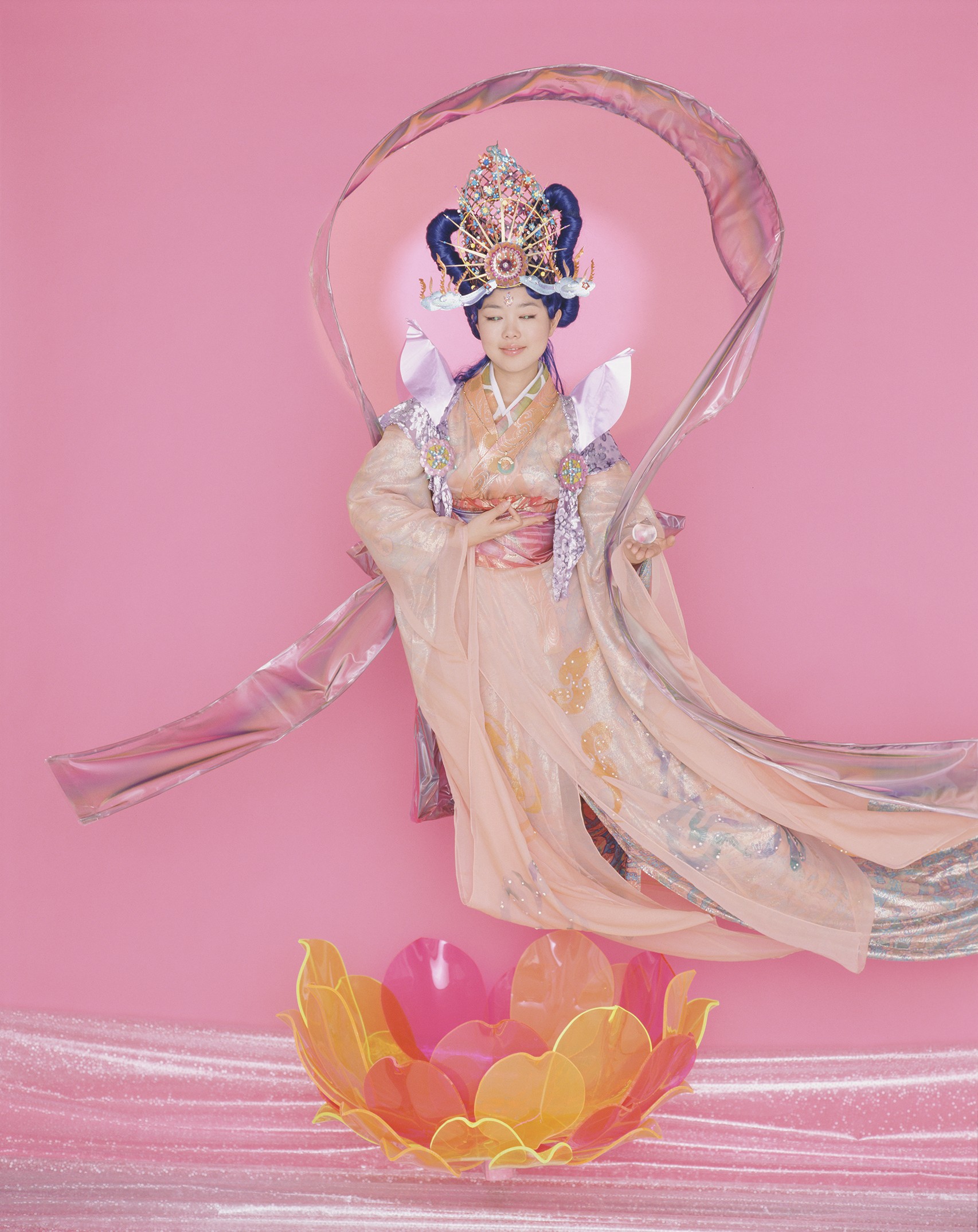
Wearing the color white in Eastern cultures can also refer to death and mourning. The choreographed movements of the orb combined with Mori’s all-white ensemble may reference the post-WWII Japanese tradition of butoh, an avant-garde style of dance performed in white body makeup with slow, hyper-controlled movements motivated by the unconscious. Mariko Mori, Miko no Inori, 1996 Color video and sound Collection of Pérez Art Museum Miami, Courtesy of Dennis and Debra Scholl Photo Laura Hoffman The overwhelming visual motifs of bright whites, illuminating background lighting, and mirror images created with the glass ball and Mori’s tiara augment the video’s meditative, transfixing aesthetic. Travelers can be seen in the background of the video continuously passing by Mori, perhaps unaware of the artist’s presence amid the airport’s shiny, reflective surfaces. Mori also incorporates the Japanese public and their environment. For Miko no Inori, Mori enlisted the help of a videographer, two choreographers, a make-up artist, a stylist, and a composer (her husband) to establish her calming but eerie presence.

The artist’s elaborate designs often require collaboration. Interested in portraying the tensions and connections between the old and new worlds of Japanese culture, Mori often integrates spiritual, otherworldly motifs with advanced technological techniques and modern aesthetics.

Wearing skimpy anime- and sci-fi-inspired costumes while interacting with the Japanese public on the subway or in business districts, Mori exaggerated the limiting, stereotypical roles available to Japanese women, while also acknowledging the growing creative role of technology. Mariko Mori, Miko no Inori, 1996 Color video and sound Collection of Pérez Art Museum Miami, Courtesy of Dennis and Debra Schollīeginning her career as a high-fashion model in Japan in the 1980s, Mori quickly transitioned to the New York art world in the ’90s, producing large-scale Cindy Sherman-esque photos of herself as various imagined characters. Perhaps using the capsule to channel energy and knowledge from the past, perhaps meditating on events of the future, the artist envisions herself as an intermediary between visible (present) and invisible (past/future) worlds. Dressed in a sleek, futuristic white dress, wearing mirrored contact lenses and a wispy white wig, all crowned by a reflective moon-shaped tiara, Mori sits in Osaka’s impressively modern Kansai International Airport rolling a clear glass orb between her manicured hands. 1967, Tokyo) sings on a hypnotic loop in Miko no Inori (The Shaman-Girl’s Prayer)(1996), currently on view at NMWA in Total Art: Contemporary Video. This Zen-apocalyptic chant is a translation of the Japanese lyrics artist Mariko Mori (b. She is ranked on the list of 3583 popular Volleyball Player.“The world is melting the world is melting, becoming one.If two unmarried celebrities are seen in public together, they are often described as “dating” which means they were seen in public together, and it is not clear whether they are merely friends, exploring a more intimate relationship, or are romantically involved. Mariko Mori prefers not to tell the details of marital status & divorce.ĭating is to describe a stage in a person’s life when he or she is actively pursuing romantic relationships with different people. Let’s take a look at Mariko Mori past relationships, ex-girlfriends and previous hookups.
#Mariko mori update#
Check back often as we will continue to update this page with new relationship details. Mariko Mori keeps his personal and love life private.
#Mariko mori full#
Full body measurements, dress & shoe size will be updated soon.

Mariko Mori’s height Unknown & weight Not Available right. Primary Income source Volleyball Player (profession).
#Mariko mori professional#
She earned the money being a professional Volleyball Player. According to Wikipedia, Forbes, IMDb & Various Online resources, famous Volleyball Player Mariko Mori’s net worth is $1-5 Million at the age of 38 years old.


 0 kommentar(er)
0 kommentar(er)
